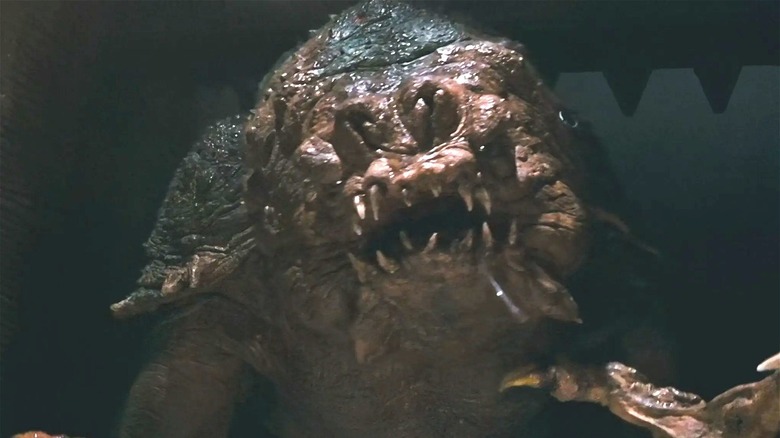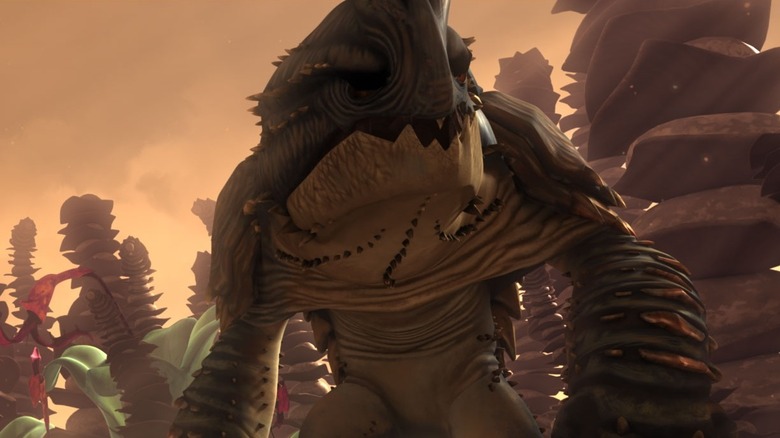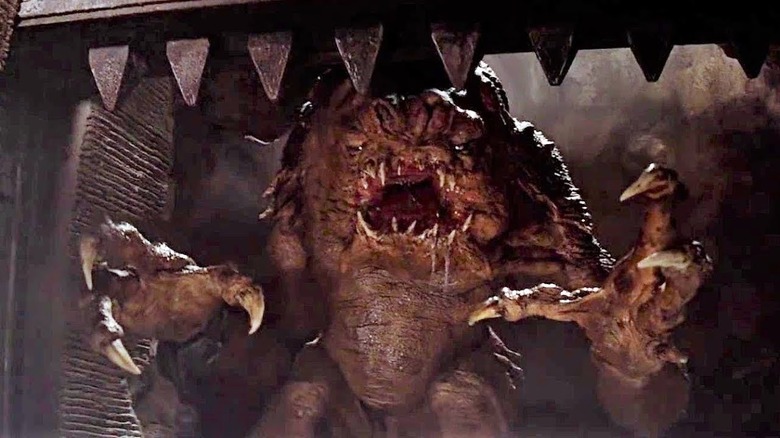The Rancors In Star Wars Explained
Of all the odd alien creatures created for the "Star Wars" universe, few are actually as iconic as the rancor. Despite only appearing for one scene in "Star Wars Episode VI — Return of the Jedi," the brutish beast beneath Jabba's basement has stayed in the hearts and minds of "Star Wars" fans everywhere. Just like Ewoks, Jawas, and whatever the heck Greedo is, the rancor has lived beyond its time in the original trilogy by appearing in all manner of spinoffs. To date, the rancor has been the focal point of an episode of "Star Wars: The Bad Batch," received its own game mode in "Star Wars Kinect," and appeared as an enemy in all manner of "Star Wars" video games both before and since then (via Fandom).
With all of that said, the series never quite takes the time to explain exactly what a rancor is beyond it being a 12-foot-tall reptilian monster. Much like the tentacled trash monster from "Episode IV — A New Hope" or the Sarlacc Pit we see later on in "Return of the Jedi," the rancor quite nearly managed to eat Luke Skywalker, and yet we still know next to nothing about it. Well, thankfully the expanded universe has done some extra work in explaining the rancors of "Star Wars."
Rancors are all over the galaxy, but originally come from one planet
As we see in "Return of the Jedi," rancors can really get around. The one we see in Jabba's Palace on Tatooine, Pateesa (yes, Jabba named his rancor), is an exotic pet taken from an entirely different system. According to the "Star Wars" wiki, the rancors hail from the planet of Dathomir, better known as the home planet of Darth Maul. The "Star Wars: The Dark Side" reference book states that this is also where the rancor were first domesticated, as the Dark Side Witches of Dathomir used them to fight off Fromprath colonizers.
Generally speaking, rancors are rather docile for their size unless otherwise provoked. Other planets that hold native rancor populations, such as Felucia, often have farmers and other rural workers establishing peaceful co-existence with herds or "crashes" of rancors. This can be seen first-hand in the "Star Wars: The Clone Wars" episode, "Bounty Hunters."
Because they have been transported to so many different planets throughout the galaxy, you can often identify different subspecies of rancors across "Star Wars" media. There are, of course, the standard brown rancors we see on Dathomir and in Jabba's Palace. However, there are also the Felucia-specific jungle rancors, as well as the rage and shadow rancors that appear in the mobile game, "Star Wars: Command."
The original rancor was supposed to be different
Outside of the "Star Wars" lore surrounding the rancor, there are some interesting facts about how and why the original rancor appeared as it did in "Return of the Jedi." According to an interview with "Star Wars" effects artist Dennis Muren, the creature was originally supposed to be played by an actor in a suit. After trying this idea and disliking it, the filmmakers then constructed the iconic puppet we know today, and used a variety of matte paintings and digital effects to complete the creature's threatening look.
The puppet itself was also incredibly small compared to the actual beast, clocking in at around 18 inches tall. Muren revealed that the film's cameramen had to take footage of the beast from up close to make it appear the correct size. They also used high-speed cameras and shot the rancor moving in slow motion. This footage was later slowed down to make it appear as if Pateesa moved at a normal speed.
Finally, when it came time for the scenes involving Luke Skywalker, actor Mark Hamill was blue-screened into Pateesa's lair, which was built to scale with the puppet and not the actors. The end result of this work, however, was a puppet that moved and felt very different from the Muppet-style puppets that audiences were already familiar with in the 1980s.


